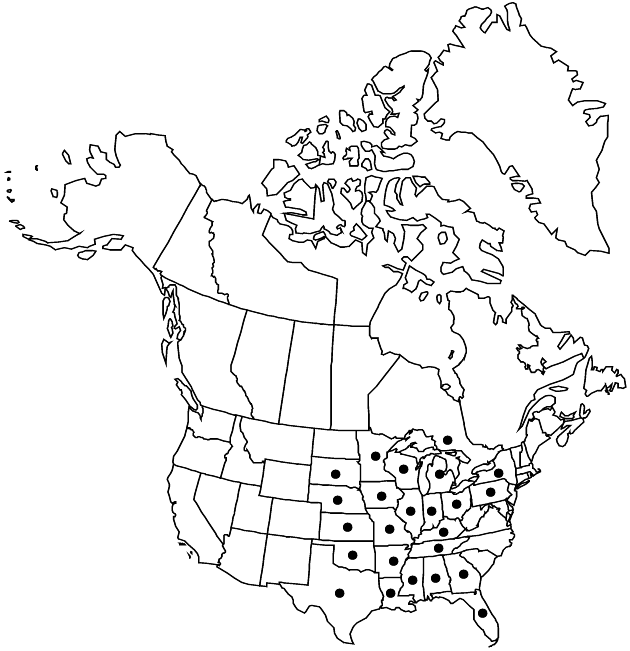Symphyotrichum oolentangiense
Phytologia 77: 288. 1995.
Perennials 20–150 cm, cespitose; short-rhizomatous or with branched, woody caudices. Stems 1–5+, erect (straight), glabrate to hispidulous, distally pilosulous to strigillose in arrays. Leaves thick, firm, margins entire or crenate-serrate, scabrous, apices mucronate, faces scabrous, abaxial strigose to piloso-strigose or hirsute, adaxial strongly strigose; basal withering by flowering, long-petiolate (petioles slightly winged, bases dilated, sheathing, ciliate), blades ovate to lance-ovate, 40–150(–180) × 10–40(–60) mm, bases ± cordate or rounded to attenuate, margins crenate-serrate to subentire, apices rounded or obtuse to acute; proximal cauline petiolate (petioles narrowly winged, clasping), blades ovate or ovate-lanceolate to lanceolate, 30–130 × 12–70 mm, gradually or ± abruptly reduced distally, bases rounded to attenuate, margins entire, scabrous, apices acute or attenuate, callus-pointed; distal sessile or sometimes short-petiolate and ± winged (appressed or ascending), blades lanceolate or linear-lanceolate to subulate, 5–80 × 1–10 mm, strongly reduced distally (more sharply so on branches), bases attenuate to cuneate or ± rounded, margins entire. Heads in open, paniculiform arrays, branches ascending, stiff, sometimes long-arching and peduncles secund, ± ridged, densely leafy with small, ± appressed branch leaves, ± strigose. Peduncles ascending, 0.2–6 cm, glabrate, densely bracteate, bracts linear-subulate, scabrous- or ciliate-margined, often revolute, grading with phyllaries. Involucres campanulate to cylindro-campanulate, 4.5–8 mm. Phyllaries in (3–)4–6 series, appressed or outer slightly spreading, lanceolate to oblong-lanceolate, strongly unequal, bases indurate 1/2–3/4, margins scarious, erose, hyaline, ciliolate, apical green zones diamond-shaped, apices acute to acuminate or caudate (then tips often involute), mucronulate to apiculate, faces glabrous. Ray florets (10–)13–20(–25); corollas usually pale to azure blue to violet-purple, (rarely rosy, white or bluish white), laminae (5–)8–12(–14) × 1.4–1.7 mm. Disc florets (15–)20–25(–30); corollas light yellow turning deep purple, 4–5 mm, tubes much shorter than narrowly funnelform throats, lobes triangular to lanceolate, 0.4–0.7 mm (lobes sparsely hairy). Cypselae dull purple or stamineous with purple streaks, oblong-obovoid, ± compressed, 1.8–2 mm, 4–5-nerved, faces glabrate to sparsely strigose; pappi cream or slightly rose-tinged, 3–4 mm. 2n = 32.
Phenology: Flowering Aug–Oct.
Habitat: Open, dry, sandy, loamy, or rocky soils, dry to wet (seasonally drying) prairies, alvars, glades, bluffs, dunes, barrens, open deciduous woods, oak and/or pine savannas
Elevation: 50–500 m
Distribution

Ont., Ala., Ark., Fla., Ga., Ill., Ind., Iowa, Kans., Ky., La., Mich., Minn., Miss., Mo., Nebr., N.Y., Ohio, Okla., Pa., S.Dak., Tenn., Tex., Wis., Mexico (Coahuila).
Discussion
A. G. Jones (1989) suggested that Symphyotrichum oolentangiense hybridizes with S. drummondii and S. laeve. Two color morphs, Aster azureus Lindley forma incarnatus Farwell and “forma albidus” (the latter not validly published and incorrectly attributed to Steyermark by M. L. Fernald 1950), have been described but are not recognized here.
Selected References
None.